What’s better than two gigantic galaxies swirling into one another until they collide? How about three galaxies swirling into one another until they collide – and they all have supermassive black holes at their core to boot! Recently, a team led by Dr. Adi Foord of Stanford combed through data from the WISE mission and the Sloan Digital Sky Survey to search for instances of three galaxies colliding with one another. In all that data, they managed to find 7 separate systems that met those criteria.
Continue reading “What Happens to Their Supermassive Black Holes When Galaxies Collide?”M87’s Black Hole is Firing Out Jets that Travel 99% the Speed of Light
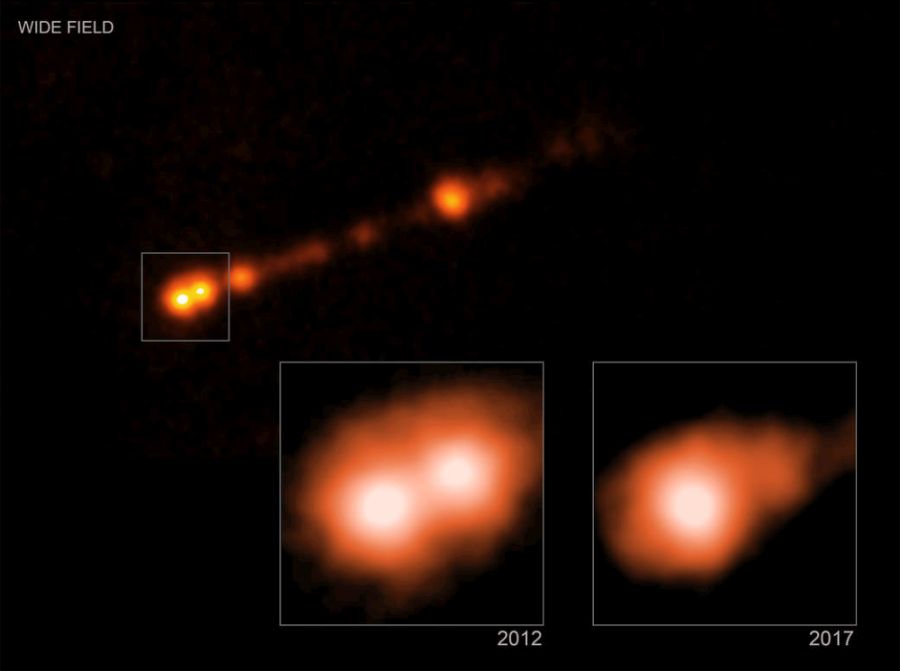
Can black holes be famous? If they can, then the one at the heart of the M87 galaxy qualifies. And this famous black hole is emitting jets of material that travel at near the speed of light.
Continue reading “M87’s Black Hole is Firing Out Jets that Travel 99% the Speed of Light”Astronomers are Continuing to Watch the Shockwaves Expand from Supernova SN1987A, as they Crash Into the Surrounding Interstellar Medium
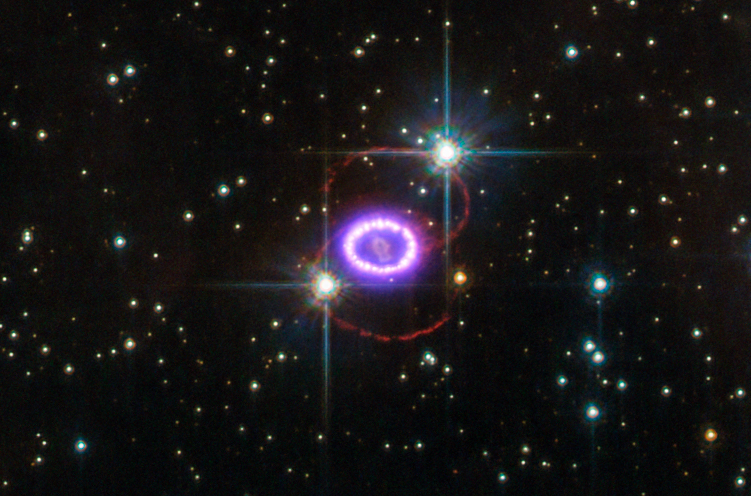
When stars reach the end of their life cycle, many will blow off their outer layers in an explosive process known as a supernova. While astronomers have learned much about this phenomena, thanks to sophisticated instruments that are able to study them in multiple wavelengths, there is still a great deal that we don’t know about supernovae and their remnants.
For example, there are still unresolved questions about the mechanisms that power the resulting shock waves from a supernova. However, an international team of researchers recently used data obtained by the Chandra X-Ray Observatory of a nearby supernova (SN1987A) and new simulations to measure the temperature of the atoms in the resulting shock wave.
Continue reading “Astronomers are Continuing to Watch the Shockwaves Expand from Supernova SN1987A, as they Crash Into the Surrounding Interstellar Medium”Stunning View of the Crab Nebula Just Got Five Times Better

Images of the Crab Nebula are always a treat because it has such intriguing and varied structure. Also, just knowing that this stellar explosion was witnessed and recorded by people on Earth more than 900 years ago (with the supernova visible to the naked eye for about two years) gives this nebula added fascination.
A new image just might be the biggest Crab Nebula treat ever, as five different observatories combined forces to create an incredibly detailed view, with stunning details of the nebula’s interior region.
Data from the five telescopes span nearly the entire breadth of the electromagnetic spectrum, from radio waves seen by the Karl G. Jansky Very Large Array (VLA) to the powerful X-ray glow as seen by the orbiting Chandra X-ray Observatory. And, in between that range of wavelengths, the Hubble Space Telescope’s crisp visible-light view, and the infrared perspective of the Spitzer Space Telescope.
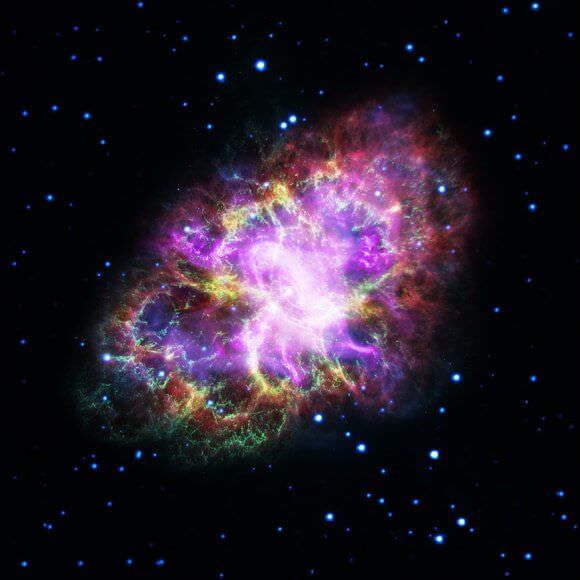
The Crab is 6,500 light-years from Earth and spans about 10 light-years in diameter. The supernova that created it was first witnessed in 1054 A. D. At its center is a super-dense neutron star that is as massive as the Sun but with only the size of a small town. This pulsar rotates every 33 milliseconds, shooting out spinning lighthouse-like beams of radio waves and light. The pulsar can be seen as the bright dot at the center of the image.
Scientists say the nebula’s intricate shape is caused by a complex interplay of the pulsar, a fast-moving wind of particles coming from the pulsar, and material originally ejected by the supernova explosion and by the star itself before the explosion.
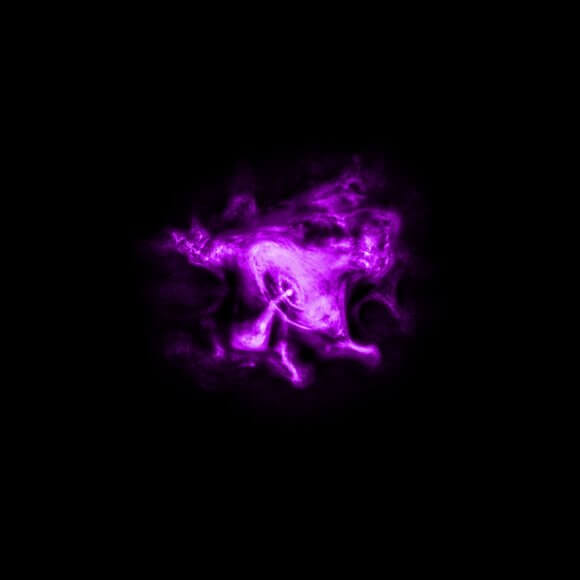
For this new image, the VLA, Hubble, and Chandra observations all were made at nearly the same time in November of 2012. A team of scientists led by Gloria Dubner of the Institute of Astronomy and Physics (IAFE), the National Council of Scientific Research (CONICET), and the University of Buenos Aires in Argentina then made a thorough analysis of the newly revealed details in a quest to gain new insights into the complex physics of the object. They are reporting their findings in the Astrophysical Journal (see the pre-print here).
About the central region, the team writes, “The new HST NIR [near infrared] image of the central region shows the well-known elliptical torus around the pulsar, composed of a series of concentric narrow features of variable intensity and width… The comparison of the radio and the X-ray emission distributions in the central region suggests the existence of a double-jet system from the pulsar, one detected in X-rays and the other in radio. None of them starts at the pulsar itself but in its environs.”
“Comparing these new images, made at different wavelengths, is providing us with a wealth of new detail about the Crab Nebula. Though the Crab has been studied extensively for years, we still have much to learn about it,” Dubner said.
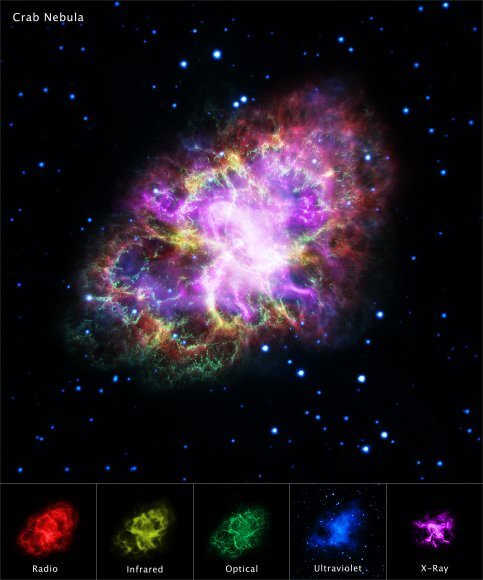
Read the team’s paper: Morphological properties of the Crab Nebula: a detailed multiwavelength study based on new VLA, HST, Chandra and XMM-Newton images
Sources: Chandra, Hubble
A Single Wave, Bigger Than the Milky Way, is Rolling Through the Perseus Galaxy Cluster
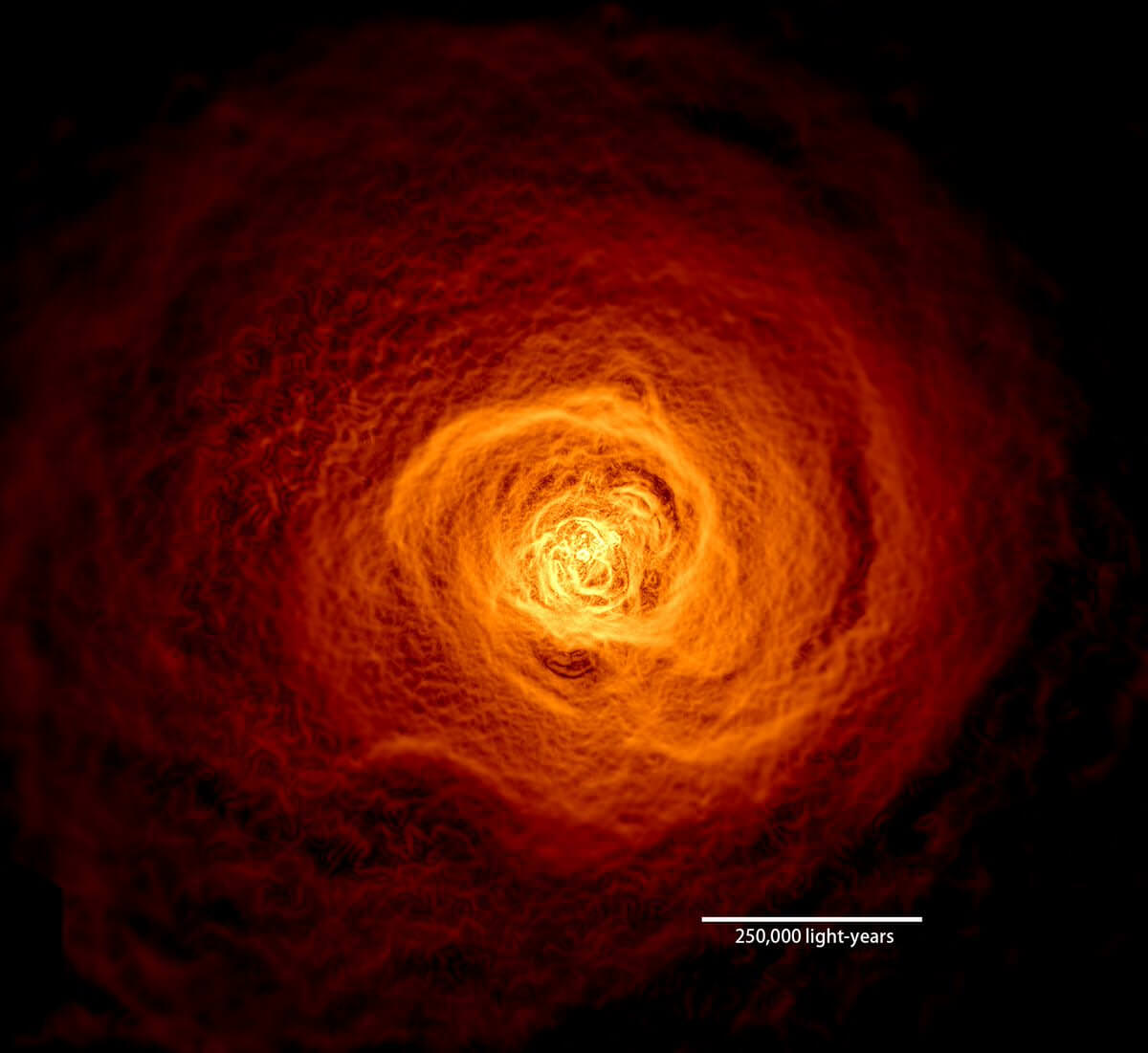
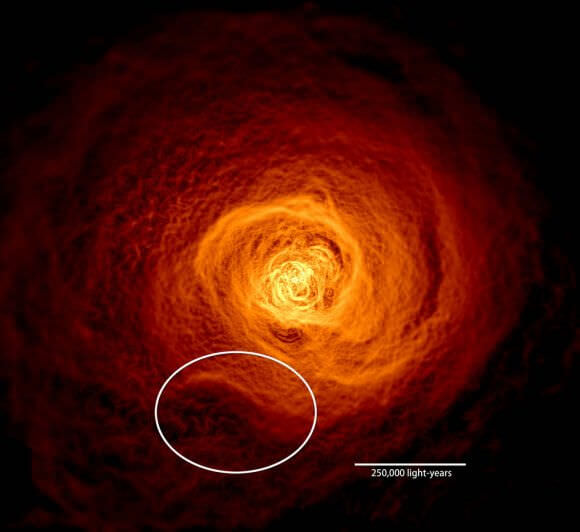
An international team of scientists has discovered an enormous wave of hot gas rolling its way through the Perseus galaxy cluster. The wave is a giant version of what’s called a Kelvin-Helmholtz wave. They’re created when two fluids intersect at different velocities: for example, when wind blows over water.
In this instance, the wave was caused by a small galaxy cluster grazing the Perseus cluster, and setting off a chain of events lasting billions of years. The findings appear in a paper in the June 2017 issue of the journal Monthly Notices of the Royal Astronomical Society.
“The wave we’ve identified is associated with the flyby of a smaller cluster, which shows that the merger activity that produced these giant structures is still ongoing.” – Stephen Walker, NASA’s Goddard Space Flight Center.
“Perseus is one of the most massive nearby clusters and the brightest one in X-rays, so Chandra data provide us with unparalleled detail,” said lead scientist Stephen Walker at NASA’s Goddard Space Flight Center in Greenbelt, Maryland. “The wave we’ve identified is associated with the flyby of a smaller cluster, which shows that the merger activity that produced these giant structures is still ongoing.”
The Perseus galaxy cluster, also known as Abell 426, is 240 million light years away, and is about 11 million light years across. It’s one of the most massive objects we know of, and it’s named after the Perseus constellation, which appears in the same part of the sky.
Galaxy clusters are the largest gravitationally-bound objects in the Universe. Most of the observable matter in galaxy clusters is gas. But the gas is super hot—tens of millions of degrees hot—which means it emits x-rays.
X-Ray observations of Perseus have revealed several features and structures in the gas structure of the cluster. Some of them are bubble-like features caused by the super-massive black hole (SMBH) in NGC 1275, the Perseus cluster’s central galaxy. Another of these features is known as “the bay.” The bay is a concave feature which couldn’t have been formed by the SMBH.
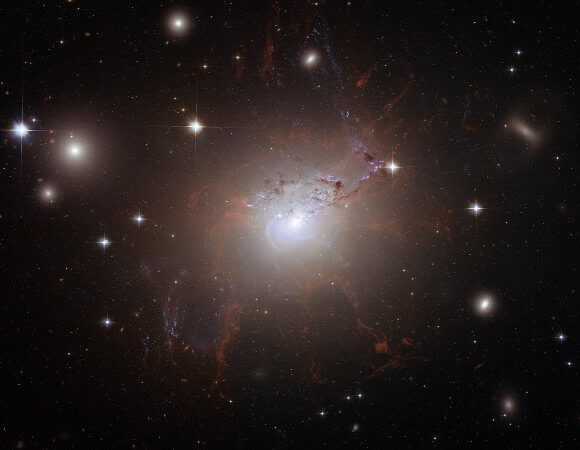
The bay is a puzzle because it doesn’t produce any emissions, which would be expected of something formed by a SMBH. The bay also doesn’t conform to models of how gas should behave in this situation.
The lead scientist behind the study is Stephen Walker at NASA’s Goddard Space Flight Center. Walker turned to the Chandra X-ray Observatory to help solve this puzzle. Existing Chandra images of the Perseus cluster were filtered in order to highlight the edges of structures, and to make any subtle details more visible.
These filtered and processed images were then compared to computer simulations of galaxy clusters merging. John ZuHone, an astrophysicist at the Harvard-Smithsonian Center for Astrophysics, has created an online catalog of these simulations.
“Galaxy cluster mergers represent the latest stage of structure formation in the cosmos.” -John ZuHone, Harvard-Smithsonian Center for Astrophysics.
“Galaxy cluster mergers represent the latest stage of structure formation in the cosmos. Hydrodynamic simulations of merging clusters allow us to produce features in the hot gas and tune physical parameters, such as the magnetic field. Then we can attempt to match the detailed characteristics of the structures we observe in X-rays.” -John ZuHone, Harvard-Smithsonian Center for Astrophysics.
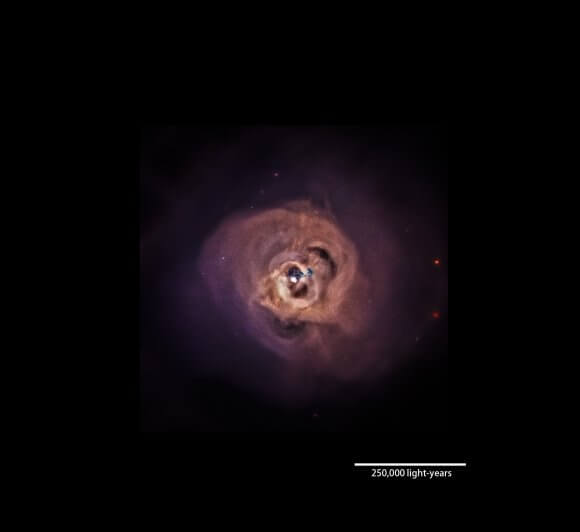
One of the simulations matched what astronomers were seeing in Perseus. In it, a large cluster like Perseus had settled itself into two regions: a colder region of gas around 30 million degrees Celsius, and a hotter region of gas at almost 100 million degrees Celsius. In this model, a cluster smaller than Perseus, but about a thousand times more massive than the Milky Way passes close to Perseus, missing its center by about 650,000 light years.
That happened about 2.5 billion years ago, and it set off a chain of events still playing itself out.
The near miss caused a gravitational disturbance that created an expanding spiral of the colder gas. An enormous wave of gas has formed at the edge of the spiral of colder gas, where it intersects with the hotter gas. This is the Kelvin-Helmholtz wave seen in the images.
“We think the bay feature we see in Perseus is part of a Kelvin-Helmholtz wave, perhaps the largest one yet identified, that formed in much the same way as the simulation shows,” Walker said. “We have also identified similar features in two other galaxy clusters, Centaurus and Abell 1795.”
The study provided another benefit besides just spotting an impossibly enormous wave. It allowed the team to measure the magnetic properties of the Perseus cluster. The researchers discovered that the strength of the magnetic field in the cluster affected the size of the wave of gas. It the field is too strong, the waves don’t form at all, and if the magnetic field is too weak, then the waves would be even larger.
According to the team, there is no other known way to measure the magnetic field.
Source: Scientists Find Giant Wave Rolling Through the Perseus Galaxy Cluster
Supernova Blast Wave Still Visible After 30 Years
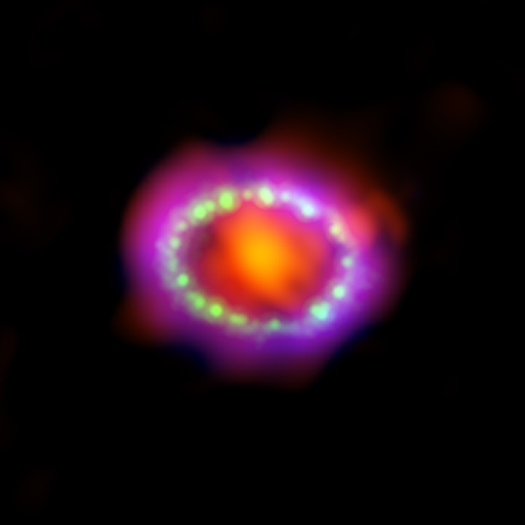
30 years ago today, a supernova explosion was spotted in the southern hemisphere skies. The exploding star was located in the Large Magellanic Cloud — a satellite galaxy of the Milky Way – and Supernova 1987A was the brightest and nearest supernova explosion for modern astronomers to observe. This has provided an amazing opportunity to study the death of a star.
Telescopes around the world and in space have been keeping an eye on this event, and the latest images show the blast wave from the original explosion is still expanding, and it has plowed into a ring expelled by the pre-supernova star. The latest images and data reveal the blast is now moving past the ring.
Got a 3-D printer? You can print out your own version of SN1987A! Find the plans here.
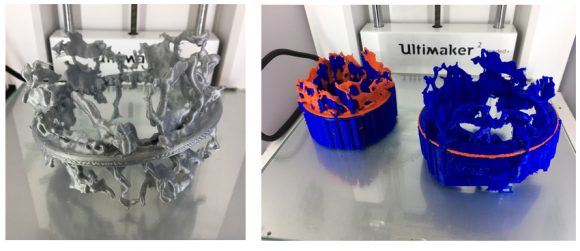
Below is the latest image of this supernova, as seen by the Hubble Space Telescope. You can see it in the center of the image among a backdrop of stars, and the supernova is surrounded by gas clouds.
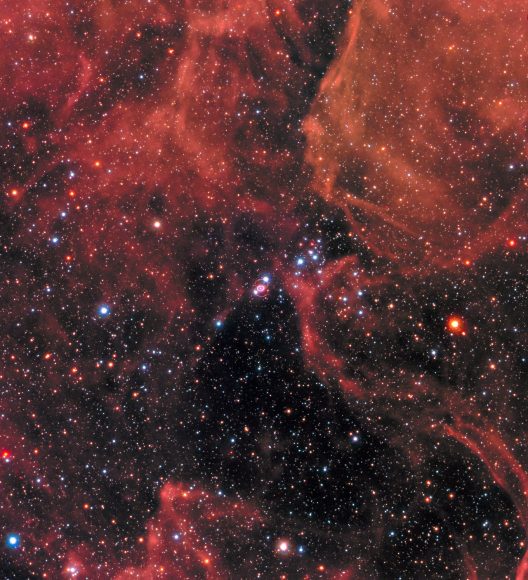
Hubble launched in 1990, just three years after the supernova was detected, so Hubble has a long history of observations. In addition, the Chandra X-ray telescope – launched in 1999 – has been keeping an eye on the explosion too.
Here are a few animations and images of SN1987A over the years:
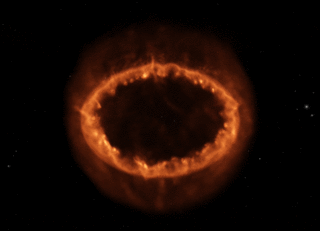
Credits: NASA, ESA, and F. Summers and G. Bacon (STScI); Simulation Credit: S. Orlando (INAF-Osservatorio Astronomico di Palermo)
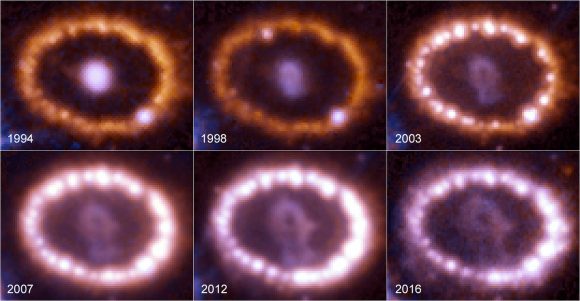
NASA, ESA, and R. Kirshner (Harvard-Smithsonian Center for Astrophysics and Gordon and Betty Moore Foundation) and P. Challis (Harvard-Smithsonian Center for Astrophysics)
Here’s a link to the original astronomer’s telegram announcing the detection.
Astronomers estimate that the ring material was was ejected about 20,000 years before the actual explosion took place. Then, the initial blast of light from the supernova illuminated the rings. They slowly faded over the first decade after the explosion, until the shock wave of the supernova slammed into the inner ring in 2001, heating the gas to searing temperatures and generating strong X-ray emission.
The observations by Hubble, Chandra and telescopes around the world has shed light on how supernovae can affect the dynamics and chemistry of their surrounding environment, and continue to shape galactic evolution.
Read all about SN1987A in our latest press release with Chandra, Hubble & ALMA https://t.co/lYiT95AabS pic.twitter.com/hTfgR0H3fW
— Kim Kowal Arcand (@kimberlykowal) February 24, 2017
See additional images and animations at the Chandra website, ESA’s Hubble website , and NASA.
A Black Hole’s Record Breaking Lunch
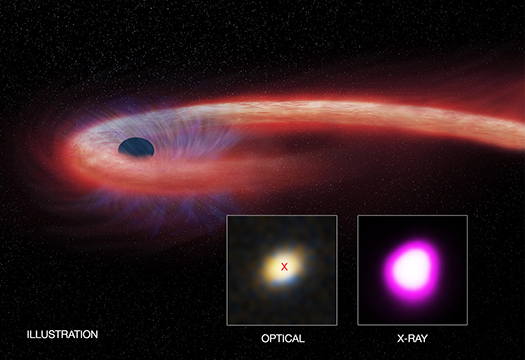
Does a distant black hole provide a new definition of pain and suffering?
The black hole, named XJ1500+0154, appears to be the real-life equivalent of the Pit of Carkoon, the nesting place of the all-powerful Sarlacc in Star Wars, which slowly digested its victims.
Over ten years ago, this giant black hole ripped apart a star and has since continued a very long lunch, feasting on the stars’ remains. Astronomers have been carefully monitoring this slow ‘digestion,’ because it is so unusual for what are called tidal disruption events (TDEs), where tidal forces from black holes tear stars apart.
“We have witnessed a star’s spectacular and prolonged demise,” said Dacheng Lin from the University of New Hampshire in Durham, New Hampshire, who led the observations of this event. “Dozens of tidal disruption events have been detected since the 1990s, but none that remained bright for nearly as long as this one.”

This decade-long feast has gone on ten times longer than any other observed TDE.
XJ1500+0154 is located in a small galaxy about 1.8 billion light years from Earth, and three telescopes have been monitoring this X-ray event: the Chandra X-ray Observatory, the Swift satellite, and the XMM-Newton.
TDEs are different from another, more common black-hole related source of X-rays in the galaxy, active galactic nuclei (AGN). Like the digestion of the Sarlacc, AGNs really can last for thousands of years. These are supermassive black holes at the center of galaxies that pull in surrounding gas and “emit copious amounts of radiation, including X-rays,” explained Lin in a blog post on the Chandra website. “Radiation from AGNs do not vary a lot because the gas surrounding them extends over a large scale and can last for tens of thousands of years.”
In contrast, TDEs are relatively short-lived, lasting only a few months. During a TDE, some of the stellar debris is flung outward at high speeds, while the rest falls toward the black hole. As it travels inwards to be consumed by the black hole, the material heats up to millions of degrees, generating a distinct X-ray flare.
XJ1500+0154 has provided an extraordinarily long, bright phase, spanning over ten years. Lin and his team said one explanation could be the most massive star ever to be completely torn apart during a TDE.
“To have the event last so long at such high luminosity requires full disruption of a relatively massive star, about twice the mass of the sun,” Lin wrote; however, “disruption of such massive stars by the SMBH is very unlikely because stars this massive are rare in most galaxies, unless the galaxy is young and actively forming stars, as in our case.
So, another more likely explanation is that this is the first TDE observed where a smaller star was completely torn apart.
Lin also said this event has broad implications for black hole physics.

“To fully explain the super-long duration of our event requires the application of recent theoretical progress on the study of TDEs,” he wrote. “In the last two years, several groups independently found that it can take a long time after the disruption of the star for the stellar debris to settle onto the accretion disk and into the SMBH. Therefore, the event can evolve much more slowly than previously thought.”
Additionally, the X-ray data also indicate that radiation from material surrounding this black hole has consistently surpassed what is called the Eddington limit, which is defined as a balance between the outward pressure of radiation from the hot gas and the inward pull of the gravity of the black hole.
Seeing evidence of such rapid growth may help astronomers understand how supermassive black holes were able to reach masses about a billion times higher than the sun when the universe was only about a billion years old.
“This event shows that black holes really can grow at extraordinarily high rates,” said co-author Stefanie Komossa of QianNan Normal University for Nationalities in Duyun City, China. “This may help understand how precocious black holes came to be.”
Lin and his team will continue to monitor this event, and they expect the X-ray brightness to fade over the next few years, meaning the supply of ‘food’ for this long lunch will soon be consumed.
For further reading:
Paper: A likely decade-long sustained tidal disruption event
Lin’s blog post on the Chandra website
Chandra press release
Additional images and information from Chandra
Solar Storms Ignite Aurora On Jupiter

The Earthly Northern Lights are beautiful and astounding, but when it comes to planetary light shows, what happened at Jupiter in 2011 might take the cake. In 2011, a coronal mass ejection (CME) struck Jupiter, producing x-ray auroras 8 times brighter than normal, and hundreds of times more energetic than Earth’s auroras. A paper in the March 22nd, 2016 issue of the Journal of Geophysical Research gave the details.
The Sun emits a ceaseless stream of energetic particles called the solar wind. Sometimes, the Sun ramps up its output, and what is called a coronal mass ejection occurs. A coronal mass ejection is a massive burst of matter and electromagnetic radiation. Though they’re slow compared to other phenomena arising from the Sun, such as solar flares, CMEs are extremely powerful.
When the CME in 2011 reached Jupiter, NASA’s Chandra X-Ray Observatory was watching, the first time that Jupiter’s X-ray auroras were monitored at the same time that a CME arrived. Along with some very interesting images of the event, the team behind the study learned other things. The CME that struck Jupiter actually compressed that planet’s magnetosphere. It forced the boundary between the solar wind and Jupiter’s magnetic field in towards the planet by more than 1.6 million kilometers (1 million miles.)
The scientists behind this study used the data from this event to not only pinpoint the source of the x-rays, but also to identify areas for follow-up investigation. They’ll be using not only Chandra, but also the European Space Agency’s XMM Newton observatory to collect data on Jupiter’s magnetic field, magnetosphere, and aurora.
NASA’s Juno spacecraft will reach Jupiter this summer. One of its primary missions is to map Jupiter’s magnetic fields, and to study the magnetosphere and auroras. Juno’s results will be fascinating to anyone interested in Jupiter’s auroras.
Here at Universe Today we’ve written about Jupiter’s aurora’s here, coronal mass ejections here, and the Juno mission here.
X-Ray Telescope Cracks Open Archives, Comes Up With Gassy Black Hole Gem
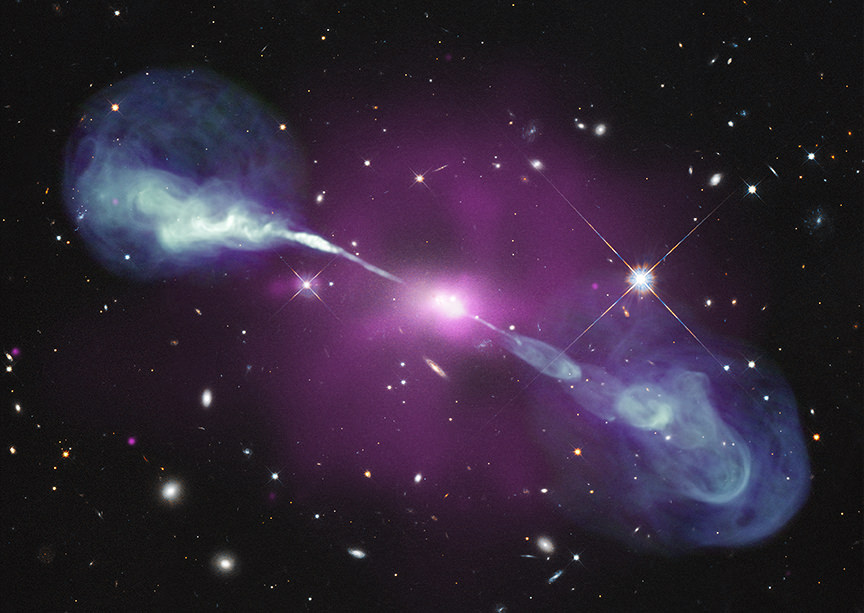
What a gem! This huge black hole in the middle of Hercules A is making gas around it super-heated to millions of degrees, making it shine brightly in X-Rays. The Chandra X-Ray Telescope captured the scene and in a new data release this week, telescope officials cracked open the archives to give us gems such as this.
The release comes as a part of American Archives Month, where every year Chandra officials go through the archives and pull out old Chandra data, combining it with the work of other telescopes to get as much information as possible about the objects being studied.
Chandra is one of three NASA “Great Observatories” still active, with the other two being the Hubble Space Telescope and the Spitzer Space Telescope. It’s been in operation now for more than 15 years.
You can see the six new pictures below. To read more about each of these objects, head on over to this link.
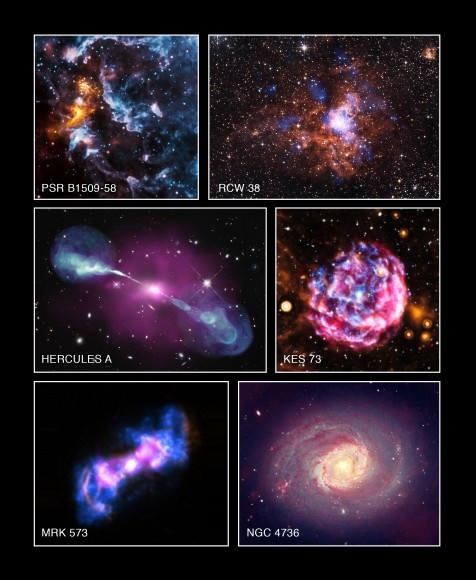
What Sparked Star Explosion 2014J? NASA Telescope Seeks Clues
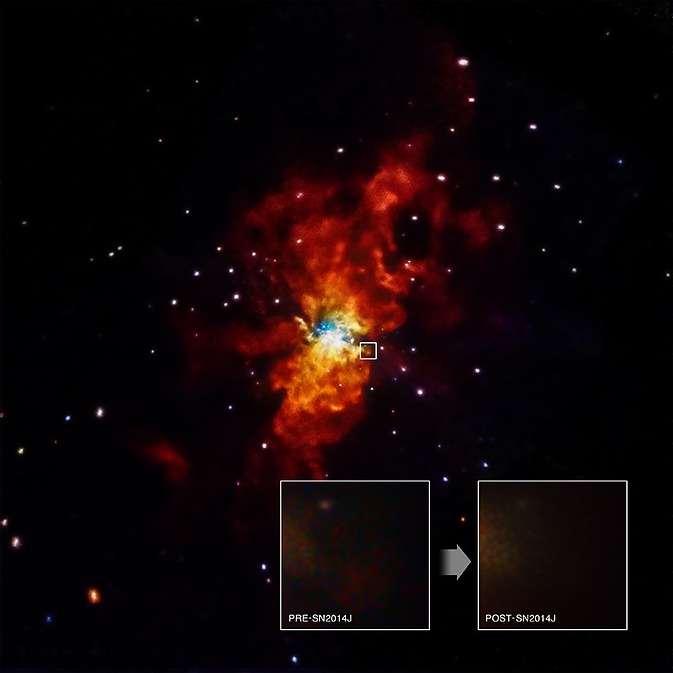
X marks the spot: after probing the area where a star used to be, in X-rays, astronomers have been able to rule out one cause for the supernova explosion.
Because the Chandra X-Ray Observatory did not detect anything unusual in X-rays, astronomers say this means that a white dwarf was not responsible for pulling off material from a massive star that exploded (from Earth’s vantage point) on Jan. 21, 2014, triggering excitement from professional and amateur astronomers alike.
“While it may sound a bit odd, we actually learned a great deal about this supernova by detecting absolutely nothing,” stated study leader Raffaella Margutti of the Harvard-Smithsonian Center for Astrophysics (CfA) in Massachusetts. “Now we can essentially rule out that the explosion was caused by a white dwarf continuously pulling material from a companion star.”
So what caused it? Possibly two white dwarfs merged instead. Follow-up observations will take place in Messier 88 and the source of the explosion, which was about 12 million light-years from Earth. While that’s a long time by human standards, astronomers point out that is close on the cosmic distance scale.
A study on this work was recently published in The Astrophysical Journal. You can read a preprint version of the article here.
Source: NASA

